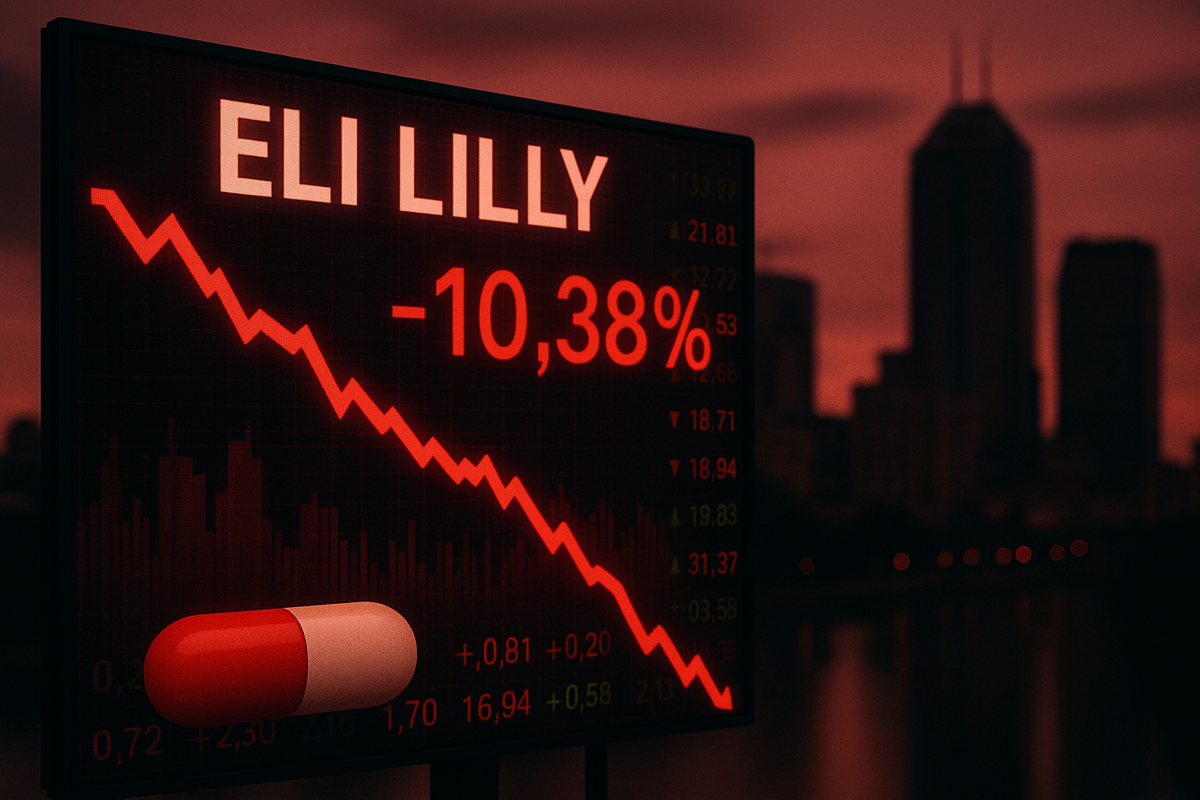
Indianapolis, IN – Shares of pharmaceutical giant Eli Lilly and Company (NYSE: LLY) experienced a significant downturn, plummeting over 10% in premarket trading and continuing to slide throughout the day, following the release of late-stage study results for its highly anticipated oral weight-loss drug, orforglipron. While the drug met its primary endpoint for weight reduction, the efficacy data fell short of the ambitious expectations set by Wall Street analysts, casting a shadow over what was otherwise a stellar second quarter for the company, marked by robust growth in its existing obesity and diabetes medicines.
This sharp decline underscores the market's intense focus on the burgeoning obesity drug market and the high stakes involved in developing the next blockbuster treatment. Despite Eli Lilly's impressive financial performance, driven by the soaring demand for its injectable GLP-1 agonists, Zepbound and Mounjaro, the perceived underperformance of orforglipron has triggered a recalibration of investor sentiment and future growth projections for the company's pipeline.
Orforglipron's Performance: A Closer Look at Disappointment
The immediate catalyst for Eli Lilly's stock slide was the detailed readout from the late-stage study of orforglipron. The trial demonstrated an average weight loss of 12.4% (approximately 27.3 pounds) over 72 weeks, which was statistically significant and met the study's primary endpoint. However, this figure landed below the 15% weight loss threshold that many analysts and investors had anticipated, especially when compared to the efficacy demonstrated by rival injectable GLP-1 drugs already on the market.
The timeline leading up to this moment has been one of escalating anticipation. Eli Lilly has been a frontrunner in the obesity treatment space, with its injectable drugs, Mounjaro (tirzepatide) for diabetes and Zepbound (tirzepatide) for weight loss, achieving remarkable commercial success. Orforglipron, an oral GLP-1 receptor agonist, was seen as a potential game-changer, offering a more convenient administration route that could significantly expand market access and patient adherence. Analysts had projected peak annual sales for orforglipron to reach as high as $12 billion to $20 billion by 2030, making it a critical component of Eli Lilly's long-term growth strategy.
Key players involved in this development include Eli Lilly's research and development teams, the clinical trial participants, and the investment community that had heavily factored orforglipron's potential into Eli Lilly's valuation. Initial market reactions were swift and decisive: a significant sell-off of Eli Lilly shares, accompanied by a surge in the stock of its primary competitor, Novo Nordisk (NYSE: NVO), whose own GLP-1 drugs, Ozempic and Wegovy, now face less immediate competitive pressure from a highly anticipated oral rival. Concerns were also raised regarding orforglipron's tolerability profile, with higher rates of gastrointestinal side effects like nausea and vomiting, leading to a 24.4% discontinuation rate on the highest dose, which further dampened investor enthusiasm.
Winners and Losers in the Wake of Orforglipron's Results
The market's reaction to Eli Lilly's orforglipron data has created clear winners and losers within the pharmaceutical landscape, particularly among companies vying for a share of the lucrative obesity treatment market.
The most immediate "winner" appears to be Novo Nordisk (NYSE: NVO), Eli Lilly's primary competitor in the GLP-1 space. Shares of the Danish pharmaceutical giant surged following Eli Lilly's announcement, as investors perceived the less-than-stellar orforglipron results as a reduction in competitive pressure on Novo Nordisk's highly successful injectable GLP-1 drugs, Wegovy (semaglutide) and Ozempic (semaglutide). Novo Nordisk also has its own oral semaglutide, Rybelsus, approved for Type 2 diabetes, and an oral semaglutide for obesity that showed 13.6% weight loss in its OASIS4 trial, with an FDA decision expected in Q4 2025. This positions Novo Nordisk to potentially be first to market with an oral GLP-1 specifically for obesity, giving them a significant advantage.
While Eli Lilly (NYSE: LLY) experienced a significant stock decline, it's crucial to note that the company is far from a "loser" in the broader sense. Its existing obesity and diabetes drugs, Zepbound and Mounjaro, continue to demonstrate exceptional growth, with sales surging by 172% and 68% respectively in the second quarter. Eli Lilly's confidence in its ability to launch orforglipron globally without supply constraints, a common issue for injectable GLP-1s, could still make it a formidable player in the oral market, even with slightly lower efficacy. The convenience of an oral medication remains a powerful draw for patients.
Beyond the two giants, smaller biopharmaceutical companies with promising obesity pipelines are also seeing shifts in their fortunes. Viking Therapeutics (NASDAQ: VKTX), developing VK2735, a dual GLP-1R/GIPR agonist in both subcutaneous and oral forms, could emerge as a beneficiary. Their subcutaneous VK2735 has shown significant weight loss (up to 14.7% at 13 weeks in Phase 2), and the oral formulation also demonstrated promising early results. Eli Lilly's "rare miss" with orforglipron's weight loss percentage could open the door for companies like Viking to carve out a niche with potentially more efficacious or differentiated oral options.
Similarly, Amgen (NASDAQ: AMGN), with its investigational antibody-peptide conjugate MariTide (maridebart cafraglutide), a bispecific GLP-1 receptor agonist and GIPR antagonist, could gain traction. Early data suggests robust weight loss (up to ~20% at 52 weeks in Phase 2) and the potential for less frequent dosing (monthly or less), which would be a significant convenience advantage. The market's renewed focus on efficacy and convenience in the oral GLP-1 space could benefit Amgen's differentiated approach. Other smaller players like Structure Therapeutics (NASDAQ: GPCR) and Terns Pharmaceuticals (NASDAQ: TERN), also developing oral GLP-1 drugs, saw their shares trade higher, indicating investor optimism for the broader oral GLP-1 market despite Lilly's specific results.
Conversely, companies with less efficacious or less convenient GLP-1 candidates, or those heavily reliant on older, less effective weight-loss drugs, may find themselves at a disadvantage. The bar for entry and success in the obesity market continues to rise, driven by the high efficacy and convenience offered by the leading GLP-1 agonists.
Industry Impact and Broader Implications
The results from Eli Lilly's orforglipron trial, while initially disappointing for investors, carry significant implications for the broader pharmaceutical industry and the burgeoning market for obesity and diabetes treatments. This event underscores several key trends and potential ripple effects.
Firstly, the pursuit of oral GLP-1 therapies remains a critical industry trend. While injectable GLP-1s like Zepbound and Wegovy have revolutionized weight management, the convenience of a once-daily pill is seen as a major step towards broader patient adoption and adherence. Orforglipron, despite its efficacy falling short of some expectations, still represents a significant advancement as an oral, small-molecule GLP-1. Its easier manufacturing process compared to peptide-based injectables could also alleviate the supply chain issues that have plagued current blockbuster GLP-1 drugs, potentially allowing for wider global access. This focus on patient convenience and ease of administration is a driving force in pharmaceutical R&D, aiming to overcome barriers to long-term treatment.
Secondly, the competitive landscape in the GLP-1 market is intensifying. The Eli Lilly-Novo Nordisk rivalry is now more nuanced. While Eli Lilly's injectable Zepbound continues to dominate in efficacy, Novo Nordisk's oral semaglutide for obesity, expected to receive an FDA decision soon, could gain a first-mover advantage in the oral segment. Eli Lilly's strategy appears to be a dual approach: offering a highly efficacious injectable and a convenient oral option to capture different patient segments. This dynamic will likely spur further innovation and investment in both oral and injectable GLP-1s, as companies strive to differentiate their offerings through efficacy, tolerability, and convenience.
Regulatory implications are also at play. Eli Lilly plans to submit orforglipron for regulatory review for weight management by the end of 2025, with a submission for Type 2 diabetes in 2026. If approved, orforglipron would be the first oral non-peptide GLP-1 agonist, setting a new precedent. The safety profile, consistent with the GLP-1 class (primarily gastrointestinal side effects), and the absence of hepatic safety signals (a crucial point given Pfizer's oral GLP-1 candidate, danuglipron, was discontinued due to liver safety issues) will be closely scrutinized by regulatory bodies.
Historically, the introduction of oral alternatives to injectable medications has often expanded patient access and market share due to increased convenience. The challenge for orforglipron will be to balance this convenience with competitive efficacy and tolerability, especially against established injectable GLP-1s that have demonstrated higher weight loss percentages. The market's reaction to orforglipron's results serves as a reminder that while convenience is highly valued, efficacy remains paramount in a competitive therapeutic area.
What Comes Next
The immediate aftermath of the orforglipron trial results will see Eli Lilly (NYSE: LLY) focusing on damage control and recalibrating investor expectations. In the short term, the company will likely emphasize the continued, robust performance of its existing GLP-1 blockbusters, Zepbound and Mounjaro, which remain significant growth drivers. Eli Lilly has already invested heavily in expanding manufacturing capacity for these drugs, and ensuring consistent supply will be critical to capitalize on their soaring demand. The company's commitment to submitting orforglipron for regulatory review by the end of 2025 indicates that despite the efficacy concerns, they still see a viable path to market for the oral drug, banking on its convenience factor.
In the long term, Eli Lilly's strategic pivots will be crucial. The company is likely to double down on its next-generation therapies, such as retatrutide, a triple agonist that has shown even greater weight reduction in earlier trials. This suggests a continued pursuit of higher efficacy, potentially through multi-hormone targeting. Furthermore, Eli Lilly's investment in oral therapies, as evidenced by orforglipron, highlights a broader industry shift towards more convenient administration methods. The company will need to carefully assess the market positioning of orforglipron, potentially targeting patient segments who prioritize convenience over maximum weight loss, or those who are needle-averse.
Market opportunities will continue to emerge as the understanding of obesity as a chronic disease deepens. Eli Lilly is already exploring expanded indications for tirzepatide (Zepbound/Mounjaro) beyond just weight loss and Type 2 diabetes, including cardiovascular risk reduction, chronic kidney disease, and metabolic dysfunction-associated steatohepatitis (MASH). These broader health benefits could significantly expand the addressable patient population and drive further adoption. The company's direct-to-consumer platform, LillyDirect, also represents a strategic move to enhance patient access and engagement, bypassing traditional pharmacy benefit manager (PBM) restrictions.
Potential scenarios for Eli Lilly range from maintaining its dominant position through a diversified portfolio of highly effective injectable and convenient oral options, to facing increased competitive pressure from new entrants with novel mechanisms of action. The most likely scenario sees Eli Lilly and Novo Nordisk remaining the clear market leaders, but with a more segmented market where different drugs cater to varying patient needs and preferences. The success of orforglipron will ultimately depend on its real-world efficacy, tolerability, and the company's ability to secure favorable pricing and reimbursement, especially as healthcare systems grapple with the rising costs of these mass-market chronic disease treatments.
Conclusion
The recent tumble in Eli Lilly's shares following the orforglipron trial results serves as a stark reminder of the high stakes and intense scrutiny within the rapidly evolving obesity drug market. While the 12.4% weight loss achieved by orforglipron met its primary endpoint, it fell short of the ambitious expectations that had been baked into Eli Lilly's valuation, particularly when compared to the higher efficacy of existing injectable GLP-1s. This event overshadowed an otherwise strong second quarter for Eli Lilly, highlighting the market's sensitivity to pipeline developments in this lucrative therapeutic area.
The key takeaway from this event is the nuanced balance between efficacy and convenience in the obesity treatment landscape. While injectable GLP-1s like Zepbound and Wegovy have set a high bar for weight loss, the demand for convenient oral alternatives remains strong. Eli Lilly's commitment to bringing orforglipron to market, despite its perceived efficacy gap, underscores the strategic importance of offering diverse treatment options to cater to a broader patient population.
Moving forward, investors should closely watch several factors. Firstly, the regulatory journey of orforglipron will be critical, as its approval would mark a significant milestone for oral non-peptide GLP-1s. Secondly, the competitive dynamics with Novo Nordisk will intensify, particularly as Novo Nordisk's own oral semaglutide for obesity approaches a potential FDA decision. Thirdly, the continued performance of Eli Lilly's existing GLP-1 portfolio, especially Zepbound, will be paramount in sustaining the company's growth trajectory. Finally, the broader industry trend towards next-generation therapies with enhanced efficacy and novel mechanisms of action will shape the long-term outlook for the obesity market, which is projected to reach well over $100 billion in the coming years. Eli Lilly remains a formidable player, but the path ahead will require strategic agility and continued innovation to navigate the evolving competitive landscape.






